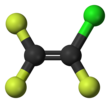This is the current revision of this page, as edited by Mondtaler (talk | contribs) at 13:16, 30 October 2024 (GHS04 and H280 specifically address hazards linked to the pressurized storage of gases. As storage methods can vary, these pictograms and hazard statements are not universally applicable to all gaseous compounds.). The present address (URL) is a permanent link to this version.
Revision as of 13:16, 30 October 2024 by Mondtaler (talk | contribs) (GHS04 and H280 specifically address hazards linked to the pressurized storage of gases. As storage methods can vary, these pictograms and hazard statements are not universally applicable to all gaseous compounds.)(diff) ← Previous revision | Latest revision (diff) | Newer revision → (diff) "CTFE" redirects here. For other uses, see CTFE (disambiguation).
| |||
| Names | |||
|---|---|---|---|
| Preferred IUPAC name 1-Chloro-1,2,2-trifluoroethene | |||
| Other names Chlorotrifluoroethene | |||
| Identifiers | |||
| CAS Number | |||
| 3D model (JSmol) | |||
| ChemSpider | |||
| ECHA InfoCard | 100.001.093 | ||
| EC Number |
| ||
| PubChem CID | |||
| RTECS number |
| ||
| UNII | |||
| UN number | 1082 | ||
| CompTox Dashboard (EPA) | |||
InChI
| |||
SMILES
| |||
| Properties | |||
| Chemical formula | C2ClF3 | ||
| Molar mass | 116.47 g·mol | ||
| Appearance | Colorless gas | ||
| Odor | faint etheral odor | ||
| Density | 1.54 g/cm at −60°C | ||
| Melting point | −158.2 °C (−252.8 °F; 115.0 K) | ||
| Boiling point | −27.8 °C (−18.0 °F; 245.3 K) | ||
| Solubility in water | 4.01 g/100 mL | ||
| Solubility | soluble in benzene, chloroform | ||
| Magnetic susceptibility (χ) | -49.1·10 cm/mol | ||
| Refractive index (nD) | 1.38 (0 °C) | ||
| Hazards | |||
| GHS labelling: | |||
| Pictograms |  
| ||
| Signal word | Danger | ||
| Hazard statements | H220, H301, H331 | ||
| Precautionary statements | P210, P261, P264, P270, P271, P301+P310, P304+P340, P311, P321, P330, P377, P381, P403, P403+P233, P405, P410+P403, P501 | ||
| NFPA 704 (fire diamond) |
 | ||
| Explosive limits | 24-40.3% | ||
| Related compounds | |||
| Related compounds | Tetrafluoroethylene Bromotrifluoroethylene Trifluoroiodoethylene Dichlorodifluoroethylene Trichlorofluoroethylene Tetrachloroethylene | ||
| Except where otherwise noted, data are given for materials in their standard state (at 25 °C , 100 kPa).
| |||
Chlorotrifluoroethylene (CTFE) is a chlorofluorocarbon with chemical formula CFCl=CF2. It is commonly used as a refrigerant in cryogenic applications. CTFE has a carbon-carbon double bond and so can be polymerized to form polychlorotrifluoroethylene or copolymerized to produce the plastic ECTFE. PCTFE has the trade name Neoflon PCTFE from Daikin Industries in Japan, and it used to be produced under the trade name Kel-F from 3M Corporation in Minnesota.
Production and reactions
Chlorotrifluoroethylene is produced commercially by the dechlorination of 1,1,2-trichloro-1,2,2-trifluoroethane with zinc:
- CFCl2-CF2Cl + Zn → CClF=CF2 + ZnCl2
In 2012, an estimated 1–10 million pounds were produced commercially in the United States.
The thermal dimerization of chlorotrifluoroethylene gives 1,2-dichloro-1,2,3,3,4,4-hexafluorocyclobutane. Dechlorination of the latter gives hexafluorocyclobutene. It undergoes cycloaddition to vinyl acetate.
References
- Lide, David R. (1998). Handbook of Chemistry and Physics (87 ed.). Boca Raton, Florida: CRC Press. pp. 3–126. ISBN 0-8493-0594-2.
- Aetna Plastics Corp. - Products. Services ... Solutions, Aetna Plastics Corp., pp. PCTFE / Kel–F® / Neoflon®, archived from the original on 27 November 2022, retrieved 3 February 2012
- Siegemund, Günter; Schwertfeger, Werner; Feiring, Andrew; Smart, Bruce; Behr, Fred; Vogel, Herward; McKusick, Blaine (2002). "Fluorine Compounds, Organic". Ullmann's Encyclopedia of Industrial Chemistry. Weinheim: Wiley-VCH. doi:10.1002/14356007.a11_349. ISBN 978-3527306732.
- Buxton, M. W.; Ingram, D. W.; Smith, F.; Stacey, M.; Tatlow, J. C. (1952). "The High-Temperature Dimerisation of Chlorotrifluoroethylene". Journal of the Chemical Society (Resumed): 3830. doi:10.1039/JR9520003830.
- R. E. Putnam, B. C. Anderson, W. H. Sharkey (1963). "1-Chloro-1,4,4-Trifluorobutadiene". Organic Syntheses. 43: 17. doi:10.15227/orgsyn.043.0017.
{{cite journal}}: CS1 maint: multiple names: authors list (link)
This article about an organic halide is a stub. You can help Misplaced Pages by expanding it. |

